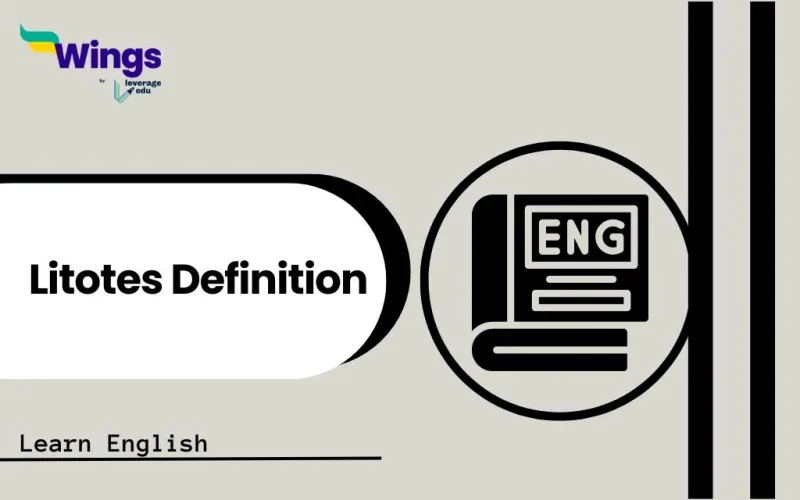Litotes Definition: Litotes is a figure of speech that helps you create and make a positive statement by saying something negative. It is like saying the opposite of what you actually mean but in a way that makes your point clear and stronger.
In this complete article, we will explain the meaning and litotes examples. We have included the different types of replies that help you understand exactly what litotes is and how it is used in different ways. Read this complete article to know about the litotes definition.
This Blog Includes:
Litotes Definition
Litotes are phrases that highlight a positive connotation by using a double negative. It is written with the word ‘not’ and the adjective opposite. In order to produce an impression, adjectives are employed in their degrees of comparison.
According to the Oxford Dictionary of Literary Terms, Litotes is a figure of speech ‘by which an affirmation is made indirectly by denying its opposite, usually with an effect of understatement.’ In simple words, Litotes is “the use of a negative or weak statement to emphasise a positive meaning.
Also Read: Euphemism: Examples, Types, Uses, Meaning, Definition
Examples of Litotes in Everyday Life, Movies, and English Literature
Litotes is a rhetorical device that expresses positive statements through negative phrasing, often creating subtle emphasis or irony. Below are various examples of litotes used in everyday speech, movies, and classic English literature to convey deeper meaning.
Examples of Litotes in Daily Life
Here are some common examples of litotes, which will help you understand the litotes definition:
| Common Litotes | Meaning |
| “Not bad” | meaning something is actually good. |
| “She’s not unkind” | implying she is kind. |
| “He’s no fool” | suggesting that he is wise or clever. |
| “That’s not a small problem” | implying it’s a big or serious problem. |
| “I’m not unfamiliar with it” | meaning you are familiar with it. |
| “It wasn’t a terrible experience” | implying it was decent or even good. |
| “He’s not the worst singer” | suggesting he might be a good one. |
| “She’s not unlike her mother” | meaning she is similar to her mother. |
| “You won’t be sorry” | meaning you’ll be happy or satisfied. |
| “It’s not impossible” | implying it’s possible. |
Also Read: Poetic Devices with Examples: 50+ list with Meaning
Examples of Litotes In Movies
Here is a list of some examples of Litotes from Movies:
| Movie | Dialogue: | Litotes |
| Pride and Prejudice | Elizabeth Bennet: “He looks miserable, poor soul.” Elizabeth Bennet: “He looks miserable, poor soul.” | ‘Not poor’ implies he is rich. |
| The Avengers | Tony Stark: “It’s not exactly a walk in the park.” | ‘Not a walk in the park’ means it is very difficult. |
| Pirates of the Caribbean | Jack Sparrow: “That’s not entirely untrue.” | ‘Not entirely untrue’ implies it is mostly true. |
| Harry Potter and the Half-Blood Prince | Dumbledore (to Harry): “You are not without talent, Harry.” | ‘Not without talent’ means Harry is quite talented. |
| The Lord of the Rings: The Two Towers | Gimli: “That’s not bad for a pointy-eared Elvish princeling.” | ‘Not bad’ implies Legolas performed admirably. |
| The Many Adventures of Winnie the Pooh | Narrator: “Now, Pooh was not the sort to give up easily.” | ‘Not the sort’ implies Pooh is very determined. |
| Aladdin | Aladdin: “This is no ordinary lamp.” | ‘No ordinary’ implies the lamp is extraordinary. |
Examples of Litotes In English Literature
Here is a list of some examples of Litotes in English Literature:
| Phrases | Writer | Litotes |
| “For he’s not stupid, blind, or disrespectful of the gods. He’ll spare a suppliant, treat him kindly.” | — The Iliad by Homer (translated) | ‘Not stupid, blind, or disrespectful’ implies he is wise, perceptive, and respectful. |
| “The question is not how to get cured, but how to live.” | — Joseph Conrad | ‘not how to get cured’ suggests the primary focus is on living rather than just survival. |
| “Not in this land shall he remain uncaught.” | — King Lear by William Shakespeare | ‘not… uncaught’ implies he will definitely be caught. |
| “I am not unaware how the productions of the Grub Street brotherhood have of late years fallen under many prejudices.” | — Jonathan Swift, A Tale of a Tub | ‘not unaware’ implies being quite aware |
| “He was not insensible to her charm.” | — Henry James, The Portrait of a Lady | ‘not insensible’ implies he was very much sensitive to her charm. |
| “It isn’t uncommon for people to change their minds.” | — George Eliot, Middlemarch | ‘isn’t uncommon’ means it is common. |
| “I cannot say that I think you are very generous to the ladies.” | — Jane Austen, Pride and Prejudice | ‘cannot say’ suggests the speaker actually thinks the opposite—that the person isn’t generous. |
| “She is not without ambition.” | — Inspired by Lady Macbeth in Macbeth by William Shakespeare | ‘not without’ means she has great ambition |
| “No mean city.” | — Acts 21:39, The Bible (King James Version) | ‘no mean’ means a great city. |
| “That is no small compliment.” | — Often found in 18th–19th century prose, used to mean “A great compliment” | ‘no small’ means a large or significant compliment. |
Also Read: What is Antithesis in Literature: Meaning, Use, Examples
FAQs
The usage of a double negative to convey a positive is known as litotes (pronounced lai-tow-teez). This type of understatement highlights a point by denying the opposite of what you wish to say. To express that you enjoy something, you could say, “That’s not bad,” for instance.
Litotes (/laɪˈtoʊtiːz, ˈlaɪtətiːz/, US: /ˈlɪtətiːz/), also known classically as antenantiosis or moderatour, are a type of irony and figure of speech in rhetoric where a negative is stated to further affirm a positive, often using double negatives for effect.
The usage of a double negative is known by its fancy word, litotes, in English. By definition, a litotes is a type of understatement that uses a double negative to emphasize a point. For example, one could use a litotes by expressing that the weather isn’t horrible today rather than that it’s pleasant today.
Litotes is the use of a negative to minimize the speaker’s or writer’s feelings or thoughts. When the speaker ought to be more animated or assertive but isn’t, this might be employed for humorous effect. It resembles a purposeful understatement that is humorous.
Synecdoche is the use of a portion to symbolize the whole (or vice versa); for example, “wheels” might be used to describe an automobile. A metaphor (such as “life is a highway”) contrasts two seemingly unconnected things by stating that one is the other.
Check other topics of Learn English here:
We hope this blog on “What is the Litotes Definition” helped you improve your English skills. You can also follow the Learn English page of Leverage Edu for more exciting and informative blogs related to English grammar and the English language.
 One app for all your study abroad needs
One app for all your study abroad needs















 45,000+ students trusted us with their dreams. Take the first step today!
45,000+ students trusted us with their dreams. Take the first step today!


